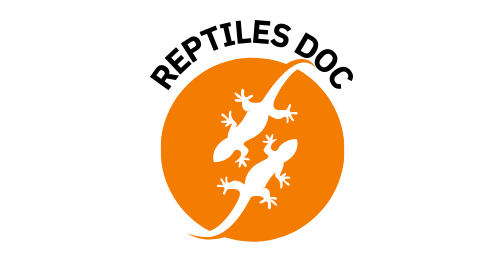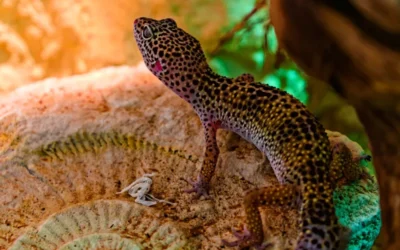Leopard geckos are fascinating reptiles known for their hardy nature and captivating patterns. As popular pets, they often raise questions about their care, including their eating habits. One common concern among owners is how long can a leopard gecko go without eating and what factors influence their appetite. While these reptiles are resilient, understanding their natural behaviors and needs is crucial for keeping them healthy.
Whether due to changes in environment, seasonal behaviors, or health issues, a gecko’s eating habits can fluctuate. By observing their behavior and maintaining optimal conditions, owners can ensure their pets thrive even during periods of reduced appetite.
How long can they go without food?
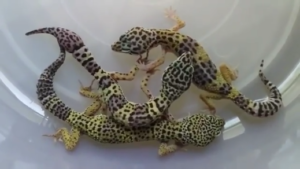
Leopard geckos are incredibly resilient creatures, capable of surviving without food for longer periods than many other pets. On average, a healthy adult leopard gecko can go without food for up to two weeks, sometimes longer, under normal circumstances.
This endurance is largely due to the fat reserves stored in their tails, which they use as a backup energy source when food is scarce. However, the exact duration they can survive without eating depends on several factors, including their age, overall health, and environmental conditions.
Young or juvenile geckos, for instance, have smaller fat reserves and are still growing, so they cannot go as long without eating compared to adults. Similarly, geckos that are ill, stressed, or kept in suboptimal conditions (like improper temperatures or humidity) may struggle to survive without food.
In brumation—a hibernation-like state some geckos enter during colder months—they naturally eat very little or nothing at all for weeks, as their metabolism slows significantly. While they can endure these periods, it’s essential for owners to monitor their gecko’s weight and behavior closely to ensure they’re not experiencing underlying health issues.
Factors Influencing How Long a Leopard Gecko Can Go Without Eating
Leopard geckos are hardy reptiles, but their ability to go without food depends on various factors. Understanding these factors helps ensure their well-being and allows owners to take appropriate measures during periods of reduced appetite. Below is a detailed list of the primary factors influencing how long a leopard gecko can go without eating.
- Age and Development Stage
Young leopard geckos require more frequent feeding due to their rapid growth and smaller fat reserves. Juveniles typically need daily or every-other-day meals to maintain energy levels, while adults can survive longer without food due to larger fat stores in their tails.
- Health Status
A healthy gecko is better equipped to endure periods without food. Illnesses such as parasites, infections, or metabolic bone disease can weaken a gecko’s body, making it harder for them to survive extended fasting. Regular veterinary check-ups are essential to ensure their health.
- Fat Reserves
Leopard geckos store fat in their tails, which acts as an energy reserve during times of food scarcity. A gecko with a thick, healthy tail can survive longer without eating than one with a thin or underdeveloped tail.
- Environmental Conditions
Temperature and humidity play a significant role in a gecko’s metabolism. When kept in suboptimal temperatures, their digestive and metabolic processes may slow down, causing appetite loss or stress. Maintaining the correct temperature gradient (around 75–85°F on the cool side and 88–92°F on the warm side) is crucial.
- Stress Levels
Stress from environmental changes, handling, new surroundings, or other pets can lead to a loss of appetite. A stressed gecko may refuse food, but minimizing stressors and giving them time to acclimate can help them resume eating.
- Brumation
During colder months, some leopard geckos enter a state of brumation, during which their metabolism slows, and they may stop eating entirely. This is a natural process, but owners should monitor their gecko’s weight and provide fresh water during this time.
While leopard geckos are capable of enduring periods without food, the duration depends on multiple factors like age, health, and environmental conditions. Owners should always monitor their gecko’s weight and behavior to ensure they remain healthy, even during temporary fasting periods. Providing proper care and a stress-free environment can help your gecko thrive and recover its appetite when ready.
Signs That Your Leopard Gecko Is Fasting vs. Starving
Understanding the difference between a leopard gecko fasting and starving is crucial for ensuring your pet’s health. Fasting is often a natural behavior, while starving is a sign of a serious issue that requires immediate attention. Here are signs to distinguish between the two.
Signs of Fasting
Fasting is a temporary and usually harmless reduction in food intake. It can happen due to natural reasons like brumation, minor stress, or environmental changes. During fasting, your gecko will:
- Maintain a Healthy Weight: Their tail (where fat is stored) remains plump and full.
- Exhibit Normal Behavior: They stay active, alert, and curious, although they might be slightly less active during brumation.
- Show No Signs of Illness: Their skin looks healthy, and their eyes are clear.
- Drink Water: They continue to hydrate regularly.
- Resume Eating Gradually: When conditions improve, such as a stabilized environment or the end of brumation, they begin eating again.
Signs of Starving
Starving occurs when a leopard gecko’s fasting goes beyond its body’s capacity, often due to underlying health issues or severe neglect. Warning signs include:
- Drastic Weight Loss: Their tail becomes thin and bony, indicating depleted fat reserves.
- Lethargy: They become unusually inactive, even during times they’d normally be awake and alert.
- Refusal to Eat: Despite offering a variety of food options, they show no interest in eating for prolonged periods.
- Sunken Eyes: This can indicate dehydration and poor overall health.
- Skin Abnormalities: Dull, flaky, or wrinkled skin can suggest malnutrition or dehydration.
- Visible Bones: The gecko’s ribs, hips, or spine may become prominent as they lose muscle mass.
What to Do
If your gecko shows signs of fasting, ensure their habitat conditions are optimal and monitor them closely. However, if they exhibit signs of starvation, consult a reptile veterinarian immediately. Prompt intervention can make the difference between recovery and more severe health consequences.
By recognizing the distinction between fasting and starving, you can take appropriate action to keep your leopard gecko healthy and thriving.
Common Reasons for a Leopard Gecko to Stop Eating
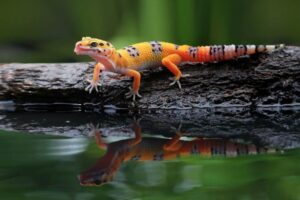
Leopard geckos are known for their reliable eating habits, but sometimes they may stop eating for a variety of reasons. Identifying the underlying cause is crucial for addressing the issue and ensuring your pet’s health. Here are some common reasons why a leopard gecko may stop eating:
- Environmental Stress
Changes in their habitat, such as incorrect temperatures, poor humidity levels, or a new enclosure setup, can cause stress and appetite loss. Ensure that the tank temperature gradient is appropriate (75–85°F on the cool side and 88–92°F on the warm side) and humidity is maintained at around 30–40%.
- Brumation
Leopard geckos may enter a state of brumation during the colder months, especially if temperatures in their environment drop. During this period, their metabolism slows, and they may eat very little or nothing at all. This is a natural process, but owners should monitor their weight and ensure they have access to water.
- Illness or Parasites
Health issues such as respiratory infections, mouth rot, or internal parasites can lead to appetite loss. Symptoms like wheezing, lethargy, visible sores, or abnormal feces are warning signs that require a veterinarian’s attention.
- Shedding
Leopard geckos often stop eating a few days before and during the shedding process. You might notice their skin becoming dull or grayish before shedding begins. This behavior is temporary, and they usually resume eating after shedding is complete.
- Stress from Handling or Changes
Excessive handling, the introduction of new tank mates, or changes in their surroundings can cause stress. A stressed gecko may hide more often and refuse food until they feel secure again.
- Dietary Preferences
Some geckos can become picky eaters, especially if they’ve grown accustomed to a specific type of food. Offering a variety of live insects, such as crickets, mealworms, or dubia roaches, can encourage them to eat.
- Impaction
Impaction occurs when a gecko ingests substrate or other materials that block its digestive tract. Symptoms include a bloated belly and lack of bowel movements. Avoid loose substrates like sand to reduce the risk of impaction.
- Breeding Season
During the breeding season, male leopard geckos may lose interest in food as they focus on mating behaviors. This temporary reduction in appetite is usually not a cause for concern unless it persists for an extended period.
- Aging
Older leopard geckos tend to eat less as their metabolism slows down with age. However, they should still maintain a healthy weight and show no signs of illness.
While occasional appetite loss is common in leopard geckos, prolonged refusal to eat may indicate an underlying issue. Regularly monitor their behavior, environment, and physical condition to identify potential problems early. If appetite loss persists or is accompanied by other symptoms, consult a reptile veterinarian for guidance.
What to Do if Your Leopard Gecko Isn’t Eating
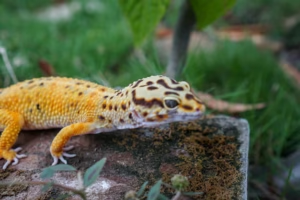
If your leopard gecko isn’t eating, it’s important to take swift action to determine the cause and address the issue. Below are the steps you can take to help your gecko get back to eating, starting with simple adjustments and progressing to more serious measures if needed.
- Check Environmental Conditions
First, ensure that your gecko’s habitat is set up correctly. Leopard geckos require a specific temperature gradient, with a cool side around 75–85°F and a warm side between 88–92°F. Make sure the humidity levels are around 30–40%. Incorrect temperatures or humidity can stress your gecko and cause it to stop eating. Ensure there are no drafts, and the enclosure is clean and comfortable.
- Observe for Stress Factors
If your gecko is stressed, it might refuse food. Stressors can include excessive handling, loud noises, new pets in the house, or a change in the enclosure setup. Try to minimize handling and keep the environment calm. If you’ve recently moved your gecko, allow it time to acclimate to the new space.
- Evaluate for Illness
If your gecko shows other signs of illness, such as lethargy, labored breathing, or visible sores, take them to a reptile vet. Illnesses such as respiratory infections or parasites can cause appetite loss. A veterinarian can diagnose and treat the problem.
- Consider Brumation
If it’s winter, your gecko may be entering a natural state of brumation, where it eats much less or stops eating entirely for a few weeks. Ensure they are still hydrated, and wait until they come out of brumation. During this period, don’t worry unless the refusal to eat lasts too long.
- Check Their Diet
Sometimes geckos stop eating because they’re bored with their food. Try offering different types of insects, such as crickets, mealworms, or dubia roaches. Ensure that the insects are appropriately sized for your gecko and gut-loaded with nutritious foods. You can also dust the insects with calcium or multivitamin powder to boost nutritional value.
- Hydration
Dehydration can contribute to appetite loss, so make sure your gecko has constant access to fresh, clean water. In some cases, you can offer water by gently misting the gecko or dipping its nose in the water to encourage drinking.
- Give Time and Space
Sometimes, the solution is simply patience. Give your gecko time to adjust if it’s dealing with stress or brumation. Try offering food at different times of the day, and provide a quiet, undisturbed environment to help them feel safe and comfortable.
- Consult a Veterinarian
If all else fails, or if you notice additional signs of health problems, take your gecko to a veterinarian who specializes in reptiles. They can perform tests for parasites or infections and provide a treatment plan. Starving can lead to severe health problems if not addressed, so it’s essential to seek professional help if the issue persists.
If your leopard gecko isn’t eating, first consider environmental, stress, and health factors. Make sure the habitat is ideal, and the diet is varied. If your gecko is still not eating after trying these steps, it’s crucial to consult with a reptile veterinarian to rule out serious health issues. Addressing the problem early can prevent long-term health complications and help your gecko return to its healthy eating habits.
Conclusion
Leopard geckos are resilient creatures and can survive for a period without food under certain conditions. How long can a leopard gecko go without eating? Typically, they can go without food for around 10 to 14 days, especially if they are in good health and have access to water.
However, this duration can vary depending on factors like the gecko’s age, overall health, and environment. While they can survive without food for some time, it’s important to ensure they are fed regularly to maintain their energy levels and overall well-being.
